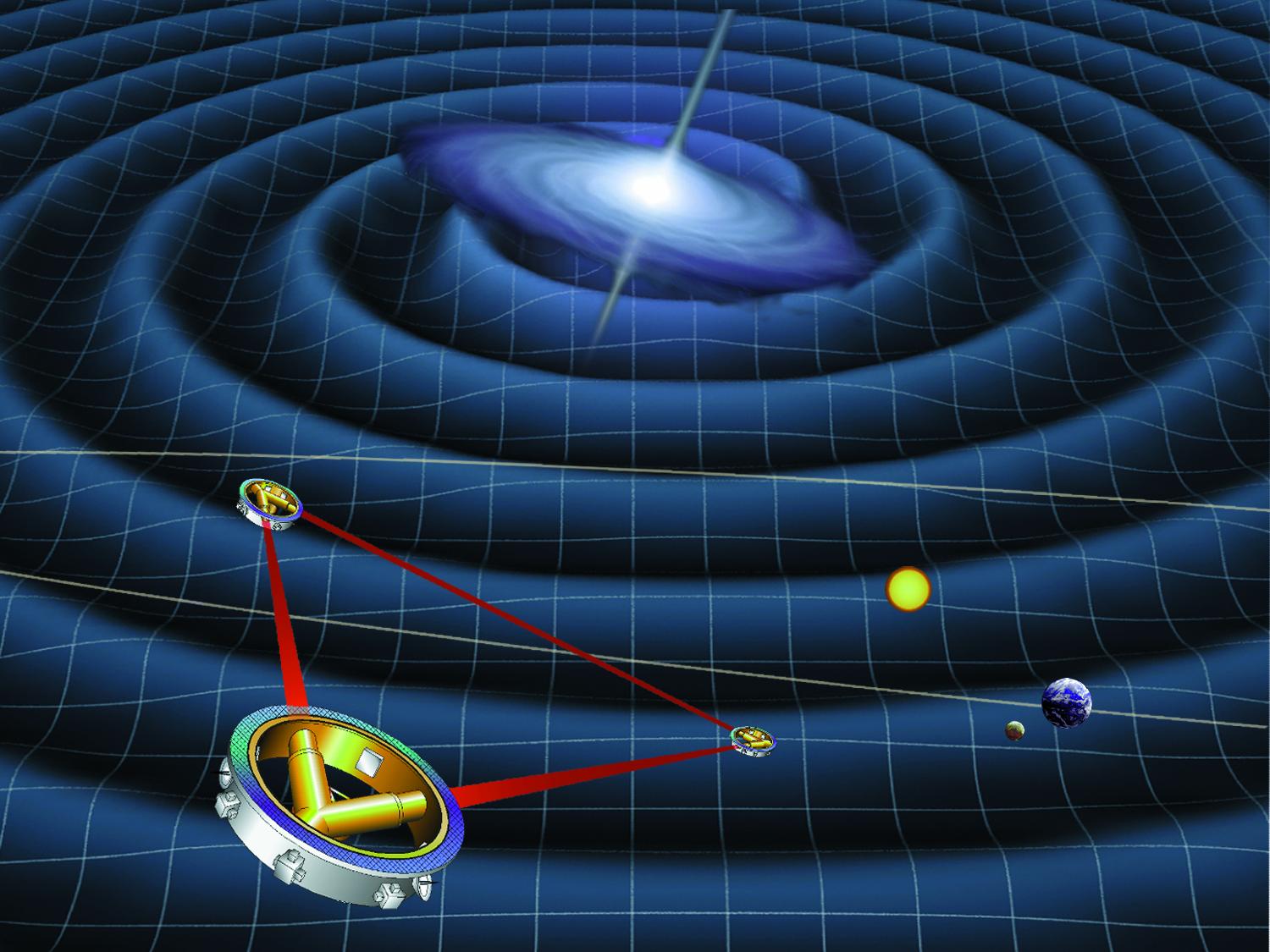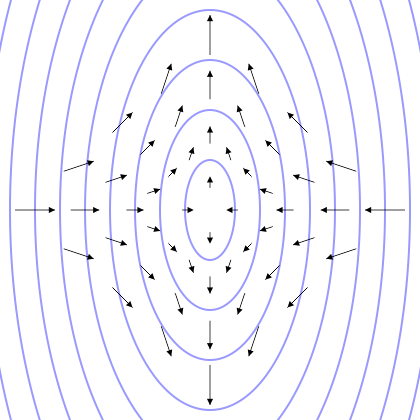|
Vanishing Dimensions Theory
Vanishing-dimensions theory is a particle physics theory suggesting that systems with higher energy have a smaller number of dimensions. For example, the theory implies that the Universe had fewer dimensions after the Big Bang when its energy was high. Then the number of dimensions may have increased as the system cooled and the Universe may gain more dimensions with time. There could have originally been only one spatial dimension, with two dimensions total — one time dimension and one space dimension. When there were only two dimensions, the Universe lacked gravitational degrees of freedom. The theory is also tied to smaller amount of dimensions in smaller systems with the universe expansion being a suggested motivating phenomenon for growth of the number of dimensions with time, suggesting a larger number of dimensions in systems on larger scale. In 2011, Dejan Stojkovic from the University at Buffalo and Jonas Mureika from the Loyola Marymount University described us ... [...More Info...] [...Related Items...] OR: [Wikipedia] [Google] [Baidu] |
Particle Physics
Particle physics or high-energy physics is the study of Elementary particle, fundamental particles and fundamental interaction, forces that constitute matter and radiation. The field also studies combinations of elementary particles up to the scale of protons and neutrons, while the study of combinations of protons and neutrons is called nuclear physics. The fundamental particles in the universe are classified in the Standard Model as fermions (matter particles) and bosons (force-carrying particles). There are three Generation (particle physics), generations of fermions, although ordinary matter is made only from the first fermion generation. The first generation consists of Up quark, up and down quarks which form protons and neutrons, and electrons and electron neutrinos. The three fundamental interactions known to be mediated by bosons are electromagnetism, the weak interaction, and the strong interaction. Quark, Quarks cannot exist on their own but form hadrons. Hadrons that ... [...More Info...] [...Related Items...] OR: [Wikipedia] [Google] [Baidu] |
Dimension (mathematics And Physics)
In physics and mathematics, the dimension of a mathematical space (or object) is informally defined as the minimum number of coordinates needed to specify any point within it. Thus, a line has a dimension of one (1D) because only one coordinate is needed to specify a point on itfor example, the point at 5 on a number line. A surface, such as the boundary of a cylinder or sphere, has a dimension of two (2D) because two coordinates are needed to specify a point on itfor example, both a latitude and longitude are required to locate a point on the surface of a sphere. A two-dimensional Euclidean space is a two-dimensional space on the plane. The inside of a cube, a cylinder or a sphere is three-dimensional (3D) because three coordinates are needed to locate a point within these spaces. In classical mechanics, space and time are different categories and refer to absolute space and time. That conception of the world is a four-dimensional space but not the one that was found n ... [...More Info...] [...Related Items...] OR: [Wikipedia] [Google] [Baidu] |
Universe
The universe is all of space and time and their contents. It comprises all of existence, any fundamental interaction, physical process and physical constant, and therefore all forms of matter and energy, and the structures they form, from sub-atomic particles to entire Galaxy filament, galactic filaments. Since the early 20th century, the field of cosmology establishes that space and time emerged together at the Big Bang ago and that the Expansion of the universe, universe has been expanding since then. The observable universe, portion of the universe that can be seen by humans is approximately 93 billion light-years in diameter at present, but the total size of the universe is not known. Some of the earliest Timeline of cosmological theories, cosmological models of the universe were developed by ancient Greek philosophy, ancient Greek and Indian philosophy, Indian philosophers and were geocentric model, geocentric, placing Earth at the center. Over the centuries, more prec ... [...More Info...] [...Related Items...] OR: [Wikipedia] [Google] [Baidu] |
Big Bang
The Big Bang is a physical theory that describes how the universe expanded from an initial state of high density and temperature. Various cosmological models based on the Big Bang concept explain a broad range of phenomena, including the abundance of light elements, the cosmic microwave background (CMB) radiation, and large-scale structure. The uniformity of the universe, known as the horizon and flatness problems, is explained through cosmic inflation: a phase of accelerated expansion during the earliest stages. A wide range of empirical evidence strongly favors the Big Bang event, which is now essentially universally accepted.: "At the same time that observations tipped the balance definitely in favor of the relativistic big-bang theory, ..." Detailed measurements of the expansion rate of the universe place the Big Bang singularity at an estimated billion years ago, which is considered the age of the universe. Extrapolating this cosmic expansion backward in ... [...More Info...] [...Related Items...] OR: [Wikipedia] [Google] [Baidu] |
Spatial Dimension
In physics and mathematics, the dimension of a mathematical space (or object) is informally defined as the minimum number of coordinates needed to specify any point within it. Thus, a line has a dimension of one (1D) because only one coordinate is needed to specify a point on itfor example, the point at 5 on a number line. A surface, such as the boundary of a cylinder or sphere, has a dimension of two (2D) because two coordinates are needed to specify a point on itfor example, both a latitude and longitude are required to locate a point on the surface of a sphere. A two-dimensional Euclidean space is a two-dimensional space on the plane. The inside of a cube, a cylinder or a sphere is three-dimensional (3D) because three coordinates are needed to locate a point within these spaces. In classical mechanics, space and time are different categories and refer to absolute space and time. That conception of the world is a four-dimensional space but not the one that was found n ... [...More Info...] [...Related Items...] OR: [Wikipedia] [Google] [Baidu] |
Temporal Dimension
In physics and mathematics, the dimension of a mathematical space (or object) is informally defined as the minimum number of coordinates needed to specify any point within it. Thus, a line has a dimension of one (1D) because only one coordinate is needed to specify a point on itfor example, the point at 5 on a number line. A surface, such as the boundary of a cylinder or sphere, has a dimension of two (2D) because two coordinates are needed to specify a point on itfor example, both a latitude and longitude are required to locate a point on the surface of a sphere. A two-dimensional Euclidean space is a two-dimensional space on the plane. The inside of a cube, a cylinder or a sphere is three-dimensional (3D) because three coordinates are needed to locate a point within these spaces. In classical mechanics, space and time are different categories and refer to absolute space and time. That conception of the world is a four-dimensional space but not the one that was found ne ... [...More Info...] [...Related Items...] OR: [Wikipedia] [Google] [Baidu] |
University At Buffalo
The State University of New York at Buffalo (commonly referred to as UB, University at Buffalo, and sometimes SUNY Buffalo) is a public university, public research university in Buffalo, New York, Buffalo and Amherst, New York, United States. The university was founded in 1846 as a private medical college and merged with the State University of New York system in 1962. It is one of two flagship institutions of the SUNY system, along with Stony Brook University. As of fall 2023, the university enrolled nearly 32,000 students in 13 schools and colleges, making it the largest public university in the state of New York. Since its founding by a group which included future United States president Millard Fillmore, the university has evolved from a small medical school to a large doctoral university, research university. Today, in addition to the College of Arts and Sciences, the university houses the largest state-operated University at Buffalo School of Medicine and Biomedical Scien ... [...More Info...] [...Related Items...] OR: [Wikipedia] [Google] [Baidu] |
Loyola Marymount University
Loyola Marymount University (LMU) is a private Jesuit and Marymount research university in Los Angeles, California. LMU enrolls over 10,000 undergraduate and graduate students, making it the largest Catholic university on the west coast of the United States. The university includes the Bellarmine College of Liberal Arts, the Frank R. Seaver College of Science and Engineering, the College of Business Administration, the School of Film and Television, the College of Communication & Fine Arts, and the School of Education. It is the parent school to Loyola Law School. LMU offers 55 major and 58 minor undergraduate programs and 47 master's degree programs, a education doctorate, a doctorate in juridical science, a doctorate in business administration, a Juris Doctor, and 13 credential programs. It is classified among "R2: Doctoral Universities – High research activity". LMU's sports teams are called the Lions and compete at the NCAA Division I level as members of the West Coa ... [...More Info...] [...Related Items...] OR: [Wikipedia] [Google] [Baidu] |
Laser Interferometer Space Antenna
The Laser Interferometer Space Antenna (LISA) is a planned space probe to detect and measure gravitational waves—tiny ripples in the fabric of spacetime—from astronomical sources. LISA will be the first dedicated space-based gravitational-wave observatory. It aims to measure gravitational waves directly by using laser interferometry. The LISA concept features three spacecraft arranged in an equilateral triangle with each side 2.5 million kilometers long, flying in an Earth-like heliocentric orbit. The distance between the satellites is precisely monitored to detect a passing gravitational wave. The LISA project started out as a joint effort between NASA and the European Space Agency (ESA). However, in 2011, NASA announced that it would be unable to continue its original LISA partnership with the European Space Agency due to funding limitations. In response, ESA continued developing the mission and in 2017, NASA re-engaged with LISA, contributing technology and scientific e ... [...More Info...] [...Related Items...] OR: [Wikipedia] [Google] [Baidu] |
Gravitational Wave
Gravitational waves are oscillations of the gravitational field that Wave propagation, travel through space at the speed of light; they are generated by the relative motion of gravity, gravitating masses. They were proposed by Oliver Heaviside in 1893 and then later by Henri Poincaré in 1905 as the gravitational equivalent of Electromagnetic radiation, electromagnetic waves. In 1916, Albert Einstein demonstrated that gravitational waves result from his general theory of relativity as ripples in spacetime. Gravitational waves transport energy as gravitational radiation, a form of radiant energy similar to electromagnetic radiation. Newton's law of universal gravitation, part of classical mechanics, does not provide for their existence, instead asserting that gravity has instantaneous effect everywhere. Gravitational waves therefore stand as an important relativistic phenomenon that is absent from Newtonian physics. Gravitational-wave astronomy has the advantage that, unlike elec ... [...More Info...] [...Related Items...] OR: [Wikipedia] [Google] [Baidu] |
Cosmological Constant
In cosmology, the cosmological constant (usually denoted by the Greek capital letter lambda: ), alternatively called Einstein's cosmological constant, is a coefficient that Albert Einstein initially added to his field equations of general relativity. He later removed it; however, much later it was revived to express the energy density of space, or vacuum energy, that arises in quantum mechanics. It is closely associated with the concept of dark energy. Einstein introduced the constant in 1917. to counterbalance the effect of gravity and achieve a static universe, which was then assumed. Einstein's cosmological constant was abandoned after Edwin Hubble confirmed that the universe was expanding. From the 1930s until the late 1990s, most physicists agreed with Einstein's choice of setting the cosmological constant to zero. That changed with the discovery in 1998 that the expansion of the universe is accelerating, implying that the cosmological constant may have a positive valu ... [...More Info...] [...Related Items...] OR: [Wikipedia] [Google] [Baidu] |
Particle Physics
Particle physics or high-energy physics is the study of Elementary particle, fundamental particles and fundamental interaction, forces that constitute matter and radiation. The field also studies combinations of elementary particles up to the scale of protons and neutrons, while the study of combinations of protons and neutrons is called nuclear physics. The fundamental particles in the universe are classified in the Standard Model as fermions (matter particles) and bosons (force-carrying particles). There are three Generation (particle physics), generations of fermions, although ordinary matter is made only from the first fermion generation. The first generation consists of Up quark, up and down quarks which form protons and neutrons, and electrons and electron neutrinos. The three fundamental interactions known to be mediated by bosons are electromagnetism, the weak interaction, and the strong interaction. Quark, Quarks cannot exist on their own but form hadrons. Hadrons that ... [...More Info...] [...Related Items...] OR: [Wikipedia] [Google] [Baidu] |








